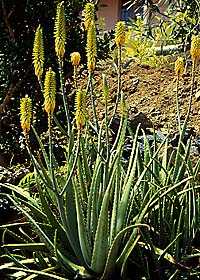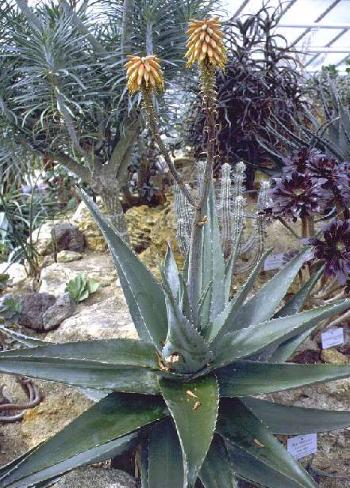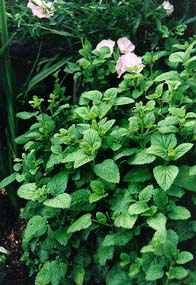 |
|
Aloe |
 |
|
Aloe |
By Karen Baar
Not just for sunburn anymore, aloe vera is a promising natural remedy for digestive disorders, feline leukemia, and possibly even cancer and AIDS.
Think of it as the oldest "new thing" around. Aloe vera, that shiny, spiny, cactus like plant so familiar to anyone who's ever had a sunburn, has been around for centuries. Lately, good old aloe vera has become the new hot topic in natural healthcare, as consumers stock up on a range of aloe products and down gallons of aloe juice and as researchers dissect the plant in search of remedies for diseases like AIDS and cancer. "If aloe were discovered today," says Jess F. Clarke, Jr., president of the International Aloe Science Council (IASC), an industry group, "it would be declared the wonder drug of the century."
But how promising are these new applications? And can the new aloe products really have an impact on your health? The fact is that aloe has been used successfully for thousands of years to treat a range of maladies, but there still are relatively few controlled studies on aloe and lots of potential applications as yet unexplored. Here's a rundown on some of the most current thinking on aloe, plus tips for choosing among the many aloe products available today
Relief in a Leaf
Aloe vera is most often used as a salve for various kinds of wounds such as minor skin irritations, cuts and scrapes, and sunburn. Alexander the Great, reportedly on Aristotle's advice, conquered an island off the coast of Africa to preserve a good source of the herb, which was used to treat his soldiers' wounds. Aloe also is a great moisturizer. Cleopatra used it to moisturize her skin, and today it is widely used in hundreds of hand creams and other cosmetic products.
Scientists think aloe is so helpful in healing skin abrasions and burns because it contains salicylates, the same painkilling and anti-inflammatory agents found in aspirin. In addition, aloe contains magnesium lactate, a substance that inhibits the histamine reactions made by the immune system in response to irritants; these reactions typically cause skin irritation and itching. While most people can use aloe without any problem, some individuals may show hypersensitivity; if you develop a rash after applying aloe, discontinue using it. In addition, aloe should not be applied to major cuts or wounds (more than skin-deep) or on skin ulcers that are larger than a dime.
One component of aloe, aloin, is extracted from the outer rind of the leaf and used as a laxative; it is classified as a drug by the Food and Drug Administration (FDA.) Not to be confused with aloe vera gel, aloin is a powerful laxative that is used in some commercial laxatives but generally is not recommended for home use, as it can cause painful cramping and irritation of the gastrointestinal tract if taken in excess. (If you use commercial aloe laxative tablets, take them judiciously; pregnant women or anyone with gastrointestinal illness should avoid these products entirely.)
Seal of Approval Confused by all of the aloe products you're seeing? One aid to consumers is a voluntary certification program established by the International Aloe Science Council, in which manufacturers who prove they're using certified raw materials and processing them according to set guidelines earn an "IASC-certified" seal. Unfortunately, products with the seal can be hard to find, "but in the next few months we'll be adding some major manufacturers to the program, says IASC spokesperson Gene Hale, so it will be easier to buy certified products." What if a product isn't certified? Look at the ingredients. The lower aloe appears on the list, the less aloe the product contains_no matter how big the words "Contains Aloe Vera" appear on the label. |
GI Juice
Beyond healing the epidermis, aloe also is useful for soothing internal tissues. Derivatives of aloe vera gel are incorporated in tonics designed to aid digestion and treat gastrointestinal (GI) problems, and medical research to support the use of aloe as a GI remedy, while still preliminary, is promising. Some studies have found significant immune-enhancing and antiviral properties in aloe, which may be responsible for its ability to soothe and heal GI tissue. Aloe also appears to slow down the emptying of the stomach and to inhibit the release of excess hydrochloric acid and the enzyme pepsin.
Ivan Danhof, Ph.D., M.D., is a gastroenterologist who is studying the use of aloe in treating inflammatory bowel disease (a group of conditions, including Crohn's disease and ulcerative colitis, that involve chronic intestinal inflammation). "Aloe has potent anti-inflammatory powers," he explains. "It lines the GI tract and stays for forty-eight hours or more. And, it may induce protective changes in the cells."
Many natural healthcare providers recommend aloe tonics to their patients with GI problems. Walter Crinnion, N.D., uses aloe-based tonics as part of a treatment program for inflammatory bowel disease in his Bellevue, Washington, practice. "Aloe is very soothing and effective at promoting healing in the intestines," says Crinnion. "I've also used it successfully in patients with chronic kidney problems—people with kidney damage who consistently show protein in their urine," he relates. (Excessive protein in the urine is a sign that the kidneys are not functioning properly.) "I've had patients drink a cup or two of aloe tonic once a day, and the secretion of protein stops."
However, one problem with prescribing aloe juice, Crinnion says, is the fact that products vary widely in how much aloe vera they actually contain. And, the concentration of aloe vera is frequently not specified—leaving the door open for variations among products in terms of formulation and efficacy. (Aloe juice is not classified as a drug by the FDA, so manufacturers are not required to list a product's aloe concentration, says Ivy Kupec, an FDA spokesperson. Except for aloin containing laxatives, there are no aloe-based remedies on the market that are classified as drugs—and thus regulated by the FDA.)
As a result, figuring the best dosage of an aloe vera product can be tricky. For example: some experts recommend drinking no more, than a quart of commercially prepared aloe juice every day. But Crinnion notes that he might prescribe a dose of one-half cup of aloe juice a day for a patient looking for a mild laxative, and so questions the laxative effect of the quart-a-day dosage. (However, he adds that aloe juice appears to be safe, even if taken in large doses.) The best strategy for adding aloe juice to your diet, says Crinnion, is a methodical one. "As you would do with any supplement, start with a low dose_maybe a quarter of cup a day_and see how your body responds. Then, if you need to, work your way up to higher dose."
Looking Ahead
Aloe is also getting lots of study for its potential for treating diseases like cancer, diabetes, and AIDS. It already is being used in many veterinary applications, including the treatment of feline leukemia. Typically over 70% percent of cats infected with the virus die within eight weeks of infection; however, in one study cats given an injected aloe derivative showed a 75 percent survival rate after eighteen weeks. In vitro studies in cats, aloe has demonstrated antiviral activity against other viruses including feline AIDS, HIV-1, influenza, and measles.
At least one pharmaceutical company is betting on aloe's potential. Carrington Laboratories, Inc., in Irving, Texas, currently markets twenty-five aloe-derived products for the treatment of various skin conditions, as well as a host of aloe-based veterinary products. At press time, Carrington was set to begin FDA Phase III trials on an aloe-derivative product designed to treat ulcerative colitis, says company spokesman Jim Blackmore.
Carrington's products make use of acemannan, a complex carbohydrate in aloe that appears to have antiviral and immune-boosting properties. That means that products utilizing it work with the body's immune system to foster healing instead of overriding immune responses as many drugs do.
Scientists also are investigating the use of acemannan in the treatment of AIDS in humans. Besides demonstrating some direct antiviral activity, acemannan seems to drastically reduce the required dosage of the anti-HIV drug AZT, a benefit both in terms of safety (AZT is associated with severe side effects) and cost.
Smart Shopping
While all of this research goes on, however, shoppers must navigate store shelves crammed with products containing aloe and trumpeting benefits—without a clear road map. "Scientific evidence on [the effects of] aloe preparations is highly specific," explains Varro Tyler Ph.D., a professor of pharmacology at Purdue University. "Results depend on the product's method of preparation, the length of time on the shelf, whether it's been diluted and to what extent."
For now, consumers must rely on manufacturers labeling and their own savvy to find the most effective products. In the meantime, knowing more about aloe processing may help you confront the staggering number of preparations on the market.
Ingredients: Aloe products are derived from the leaves of the aloe plant. Aloe vera is the clear gooey substance found in the center of the leaves; aloe vera concentrate is gel from which the water has been removed. Aloe vera juice is made from the gel. Aloin, a laxative agent, is found in the liquid, called latex, contained in the outer rind of the leaf.
Concentration: According to IASC president Clarke, consumers should look for at least a 20 percent concentration of aloe in a cosmetic preparation. Tonics ought to be least 70 percent aloe.
Processing: In most cases, commercially grown aloe follows this path, says Gene Hale, a spokesperson for IASC: It's harvested, refrigerated, processed (either ground as a whole leaf or separated, gel from the rind), treated with preservatives, pasteurized, and concentrated (to a strength between 10 and 199 times its original). Then it's reconstituted and turned into its final incarnation (cream, tonic, etc.) or, in the case of pharmaceutical applications, freeze- or spray-dried for use as an internal remedy.
 |
Grow (And Use) Your Own A tropical plant that thrives outdoors, aloe vera prefers full sun but will tolerate some shade. (If you live in an area with cold winters, bring it inside: temperatures below about 40 degrees will kill it.) Use a coarse potting mixture—fairly lean, without much compost or peat—and let the soil dry out before watering. To use your aloe plant to treat a burn, break or cut off a leaf (use the outer leaves first as they are the oldest). Slice the leaf down the middle, and apply the gel to the skin; reapply often (about five or ten times a day). For a large burn or sore, you can make a poultice by putting the cut leaf directly onto the wound and wrapping it in gauze. |
Karen Baar writes about a wide range of health issues. She lives in Woodbridge, Connecticut.
Reprinted with permission from Natural Health, Nov/Dec 1995. For a trial issue of Natural Health, call 1-800-526-8440.

Lemon Balm